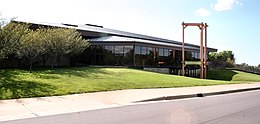Conner Prairie
[8] Earlham elected to retain the farmland and expand the museum, constructing an 1836 village (Prairietown) with funds provided by Lilly for the purpose.The Indiana attorney general intervened and, after a lengthy and contentious dispute, a settlement was reached in which Earlham resigned as trustee of the charitable trust, the Lilly endowment was allocated between Conner Prairie and the college, and the museum became independent.[5] On December 17, 2010, Conner Prairie received the National Medal for Museum and Library Service and a $10,000 prize in a ceremony at the White House.[13] The museum's main building, the Welcome Center, contains the entrance lobby, ticket-sales counter, "Create.Connect" (history and science exhibits), Discovery Station/Craft Corner indoor play area, banquet hall, and gift shop.Conner Prairie has several permanent attractions and a number of semi-regular events, including monthly programs such as "Taste the Past", a Headless Horseman ride in the autumn, candlelight tours, and a country fair.The area consists of smaller exhibits that explore wind energy at the turn of the century, flight in the early 1900s, rural electrification in the 1930s, and the role of science during the space race of the 1950s and 1960s.Children of all ages can participate in basic trade activities such as sewing on a button, hammering in a nail, or molding a piece of metal.It houses several heritage breed livestock that the museum helps to conserve, including Arapawa goats, Tunis sheep and American rabbits.[16] The barn allows guests to familiarize themselves with and become comfortable around livestock, develop an appreciation for where food comes from and understand why conserving rare genetics is important for modern agriculture.[17] Built in 1823, the William Conner House is a two-story, Federal-style brick residence on the terrace edge of the west fork of the White River.[5] Using live action, video, and other interactive activities, the Civil War Journey documents the raid through the eyes of historical figures Attia Porter, Confederate brigadier general John Hunt Morgan, and Albert Cheetham.[12] Visitors can walk through a reconstruction of the town of Dupont and be a part of the Civil War; children can board a replica steamboat and play in the water area.Visitors can stop by the Mayfield and Nichols dry-goods store, the Porter family home, a telegraph station, a soldiers' camp and a field hospital.Although these interpreters will not discuss events (or inventions) after 1836, blue-shirted museum employees can help visitors approach Prairietown from a modern point of view.The attraction is based on the August 17, 1859, trip by John Wise, who made the first airmail delivery in the United States – 25 miles (40 km), from Lafayette to Crawfordsville, Indiana – of 123 letters and 23 circulars.



Hamilton County, IndianaCoordinatesU.S. National Register of Historic Placesliving history museumFishers, IndianaWilliam ConnerNational Register of Historic PlacesWhite RiverIndianapolis Symphony Orchestrasummer campsbaseballEli LillyEarlham CollegeRichmond, Indianaboard of directorsendowmentSmithsonian AffiliationsNational Medal for Museum and Library ServiceMorgan's RaidHeadless HorsemanAmerican Civil War reenactmentsChristmasHoosierwindmillcircuitschain reactioninterpretertextilesmetalworkingwoodworkingheritage breedArapawa goatsTunis sheepAmerican rabbitsEnglish LonghornOssabaw HogsFederal-styleterracewest fork of the White RiverHamilton CountyLenapeMekinges ConnerEli Lilly and CompanyIndiana Historical Societybrigadier generalJohn Hunt MorganDupontpottery wheelblacksmithpotteryheliumAerophileLafayetteballooningJohn WiseairmailCrawfordsville, IndianaLenape (Delaware)cattailwigwamsfur tradelog cabinhuntingbeadingweavingIndianatomahawkslaveryreenactmentUnderground RailroadAmerican Alliance of MuseumsAmerican Civil Liberties UnionList of museums in IndianaList of open-air and living history museums in the United StatesNational Park ServiceIndianapolis StarThe Indianapolis StarContributing propertyKeeper of the RegisterHistoric districtHistory of the National Register of Historic PlacesProperty typesBartholomewBentonBlackfordCarrollClintonCrawfordDaviessDearbornDecaturDeKalbDelawareDuboisElkhartFayetteFountainFranklinFultonGibsonGreeneHamiltonHancockHarrisonHendricksHowardHuntingtonJacksonJasperJeffersonJenningsJohnsonKosciuskoLaGrangeLaPorteLawrenceMadisonMarion: Center TownshipMarion: OtherMarshallMartinMonroeMontgomeryMorganNewtonOrange